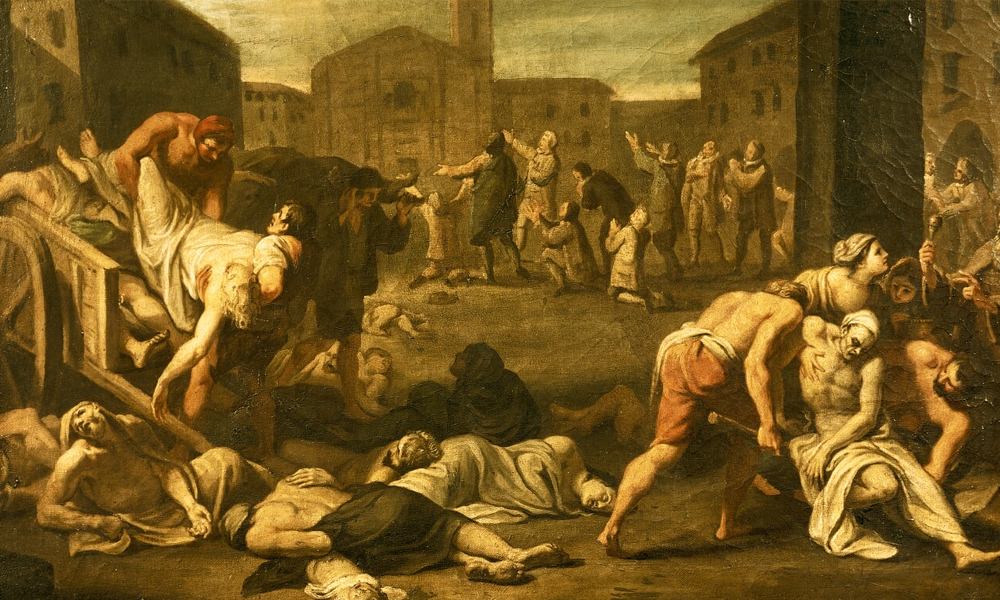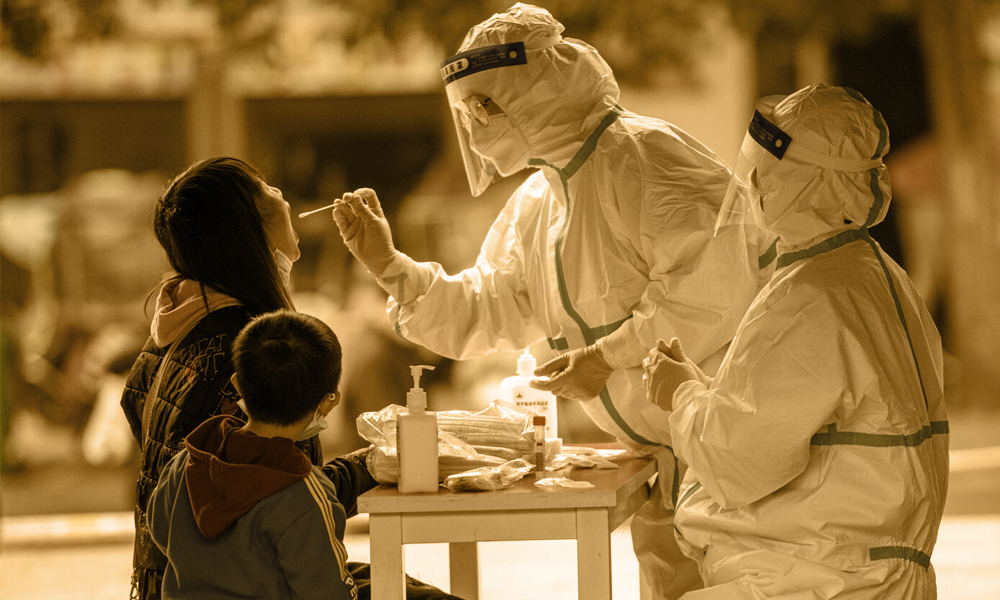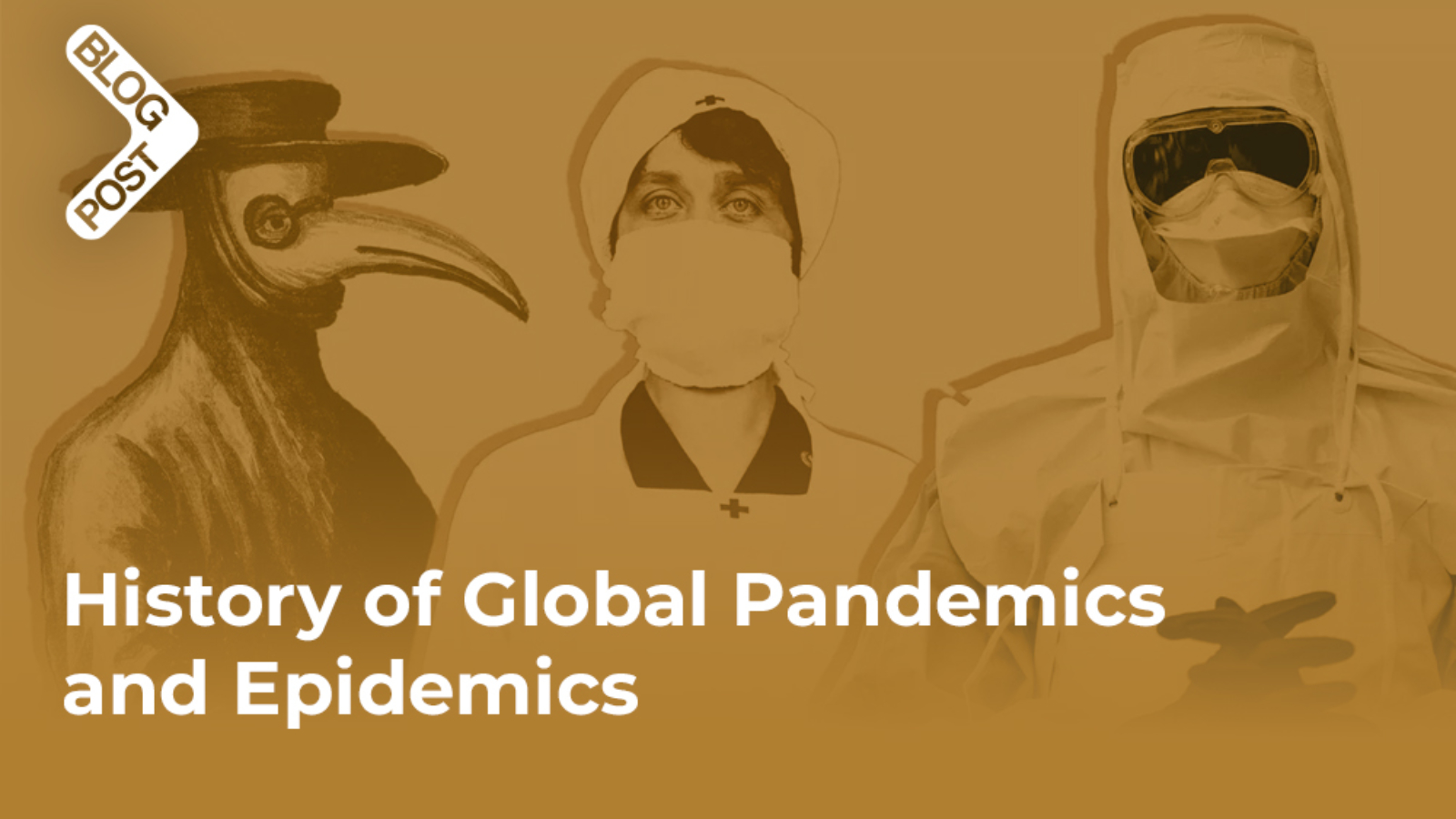
Introduction: The Impact of Pandemics on Humanity Throughout History
A little over four years ago, the world was reminded once again of the frailty of life, illness, death, global disease, and global disruption by the COVID-19 pandemic. Words like quarantine, lockdown, pandemic, social distancing, hand-washing, sanitizers, and isolation, among others became a part of our day-to-day language. The impact of the most recent pandemic was far-reaching worldwide. The social, emotional, economic, and political disruption felt in the wake of the COVID-19 pandemic is starkly reminiscent of the generalized impact associated with pandemics and epidemics from time immemorial.
Pandemics and epidemics have always been a part of human history, and they remain so as the COVID-19 pandemic proved just recently. Pandemics and epidemics of flu, cholera, malaria, and HIV/AIDS are still a part of daily living across the world. From medieval times to the present time, humans have lived with disease causing organisms, and human disruption of the social and biological strata often leads to infection with some disease causing organisms, with increased industrialization and globalization leading to the eventual spread beyond the initial area of contact.
Pandemics and Epidemics are used to show the extent of the spread of infectious and non-infectious disease conditions, with the difference being the extent and area of spread. To help understand the difference between epidemic and pandemic, it is crucial to also understand some key public health terms such as outbreak and endemic. An outbreak refers to an unexpected increase in the number of people with a particular health condition or the spread of a health condition in a new area. Endemic means that the health condition occurs at an anticipated rate in a geographical area. An epidemic is an outbreak that spreads to a larger geographical area; meaning an unexpected increase in health conditions or new cases of a health condition across larger geographical areas. Pandemic is an epidemic that spreads across continents globally.1,2
From Ancient Times To The Middle Ages: Historical Pandemics
Pandemics have been around since ancient times. Some of the pandemics recorded in history from ancient times to the Middle Ages include:
- Athenian Plague: This occurred between 430-26 BC during the Peloponnesian war between Athens and Sparta.3 Originating from Ethiopia and spreading throughout Egypt and Greece, the initial symptoms were headaches, conjunctivitis, body rash, and fever followed by later symptoms of hemoptysis (coughing out blood), stomach pain, vomiting, and eventual death in most people.3,1 The war led to the rapid spread of the disease and was marked by the mortality of about 25% of the city’s population, despair, and breakdown of law and order.3, 1
- Antonine Plague: Also known as the ague of Galen, it occurred between 165 – 180 AD in the Roman Empire.1 It was transmitted into the Empire by soldiers returning from war, spreading to a larger geographical area including Asia Minor, Greece, Egypt, and Italy.4 About 33% of the population or 5 million people including Marcus Aurelius, the emperor, died of the pandemic.4,3 Symptoms were rashes, fever, pustules, and bloody diarrhea.1,3 It is thought to be part of the factors that led to the downfall of the Roman Empire.
- Justinian Plague: Named after Justinian 1, the Byzantine emperor at that time, the plague caused by Yersinia pestis occurred in 541 CE ravaging the Roman world and beyond.5 Hallucinations preceded other symptoms such as fever; cough fatigue; buboes in the groin, armpit, or behind the ear; lethargy, and eventual death.3,1 Between 5,000 – 10,000 people were thought to have died daily in Constantinople, and total death from the plague is estimated to be between 25 – 100 million.4,5 The emperor himself was infected, but he didn’t succumb to the plague.5 The plague resulted in food scarcity, starvation, economic instability, breakdown of law and order, and a stop in the military conquest of Rome.5,3
The Black Death: Also known simply as the Plague, it is thought to be the most fatal pandemic in human history. Originating from China in 1334, the plague spread across Europe, Asia, and Africa and was caused by the bacterium Yersinia pestis.6,1 Symptoms included fever, chills, fatigue, vomiting, buboes.2 The Plague is thought to have claimed 75 – 200 million lives and wiped out about 30% of Europe’s population. 2,4,1 Economic instability, the emergence of the middle class, the breakdown of law and order, antisemitism, turmoil, widespread destruction, food scarcity, and starvation were some of the aftermaths of the plague.6

New World and Eurasia Pandemics
The European exploration of the Americas known as the Columbian Exchange resulted in the exchange of more than just food, animals, plants, ideas, and population. Disease exchange was another important tradeoff. Prior to the invasion by the Europeans, the Native Americans had no contact with diseases that affected Eurasia such as smallpox, whooping cough, malaria, influenza, typhus, diphtheria, and chickenpox, hence; they had no immunity to the diseases.7,8
In the years after the exploration, these diseases became epidemic in the New World (The Americas). The mortality rate in various villages, cities, and towns was as high as 80%, and 90%, and in some cases, entire populations such as the Taino people were wiped out and became virtually extinct.8
The massive loss of human lives led to disruption in ecosystem as forests grew rapidly and animals increased.9 Economically, labour shortage ensued and also led to the Transatlantic Slave Trade establishment.9

Industrial Revolution and Pandemics in the Modernization Process
The 18th, 19th, and 20th centuries heralded huge development in industrialization, modernization, and technological advancement. Rise in infectious diseases, and resultant pandemics and epidemics were also part of this development. Notable among these are the cholera pandemic, the Spanish flu, and the Asian Flu.
Asian Flu: This was caused by the H2N2 influenza virus in 1957 which originated from China.4 It spread to the United States of America, Hong Kong, England, Scotland, and Singapore within months.1, 4,11 The estimated death toll during the pandemic is between 1 – 2 million. 1,4,11
The Seven Cholera Pandemics: Caused by the bacterium Vibrio cholera, and spread through the fecal-oral route, the cholera pandemic was formerly endemic to Asia until 1817 when it spread from India to other parts of the world in what is known as the first cholera pandemic.2,10 Advancements in transportation systems aided it’s rapid spread. Subsequently, five other cholera pandemics occurred between 1827 to 1923. During the third cholera pandemic, the physician John Snow was able to trace the source of the outbreak to contaminated public water2. The seventh cholera pandemic began in 1961, and it is thought to be ongoing.1 The cholera pandemic led to sanitation emerging as a public health measure.2, 10
The Spanish Flu: The 1918 Spanish flu pandemic started in Kansas and was spread by troops.1 The H1N1 of avian origin was the cause of the Spanish flu, and symptoms were cough, fever, weakness, malaise, and nose bleeding in some mild and severe cases.1, 3 Personal hygiene and quarantine were the major public prevention health measures put in place during the pandemic.1
Asian Flu: This was caused by the H2N2 influenza virus in 1957 which originated from China.4 It spread to the United States of America, Hong Kong, England, Scotland, and Singapore within months.1, 4,11 The estimated death toll during the pandemic is between 1 – 2 million. 1,4,11

Global Pandemics and Epidemics in the Modern Era
In modern times, pandemics and epidemics still continue to be a big part of our lives. Viruses majorly affecting the respiratory system have led to several epidemics and pandemics in the modern era. The HIV/AIDS pandemic is also another modern pandemic that humans still grapple with.
- The HIV/AIDS pandemic: In the 1980s, scientists first discovered the Human Immunodeficiency Virus (HIV) in the United States of America.3 It spreads through contact with body fluid such as blood, and breast milk, and through sexual intercourse and from an infected mother to her unborn child.11 HIV attacks and weakens the immune system, especially as it progresses to AIDS (Acquired Immune Deficiency Syndrome) if left untreated.11 The HIV/AIDS pandemic affects people across countries and populations, and it is more prevalent in Sub-Saharan African countries. Worldwide, HIV is thought to affect about 40 million people.3,11 It is one of the pandemics that has received widespread attention from local, regional, and global public health institutions and pharmaceutical companies in terms of research, funding, and treatment.1
- SARS: The Severe Acute Respiratory Syndrome (SARS) was caused by the severe acute respiratory syndrome coronavirus (SARS CoV), and it originated in China in 2003 spreading to 29 countries.1,2 Case identification, contact tracing, isolation, and surveillance were the public health measures used in containing the spread of the pandemic.1
- MERS: Middle East Respiratory Syndrome (MERS) was caused by the Middle East Respiratory Syndrome Coronavirus (MERS CoV) which was first reported in Saudi Arabia.1,2 Symptoms include cough, sore throat, fever, and chills and those above 65 years are more likely to have severe disease.2
COVID-19 Pandemic: New Pandemic Challenge of The 21st Century
Spreading from Wuhan, China to the rest of the world faster than earlier pandemics, the COVID-19 pandemic showed how swiftly pandemics can spread in this era owing to improvements in transportation, technology, and globalization. The COVID-19 pandemic is caused by the Severe Acute Respiratory Syndrome Coronavirus-2 (SARS-CoV-2). The Coronaviruses belong to the family Coronaviridae, and there are four genera which are alpha, beta, gamma, and delta. The SARS CoV, MERS CoV and the SARS-CoV-2 are all in the beta-coronavirus genera.2
Dry cough, fever, fatigue, malaise, rhinorrhea, headache, shortness of breath, nausea, vomiting, diarrhea, and loss of sense of smell (anosmia) were some of the symptoms of the pandemic. 1,2,4 The COVID-19 pandemic led to a lot of public health measures. Isolation, quarantine, physical distancing, use of face masks, appropriate coughing etiquette, case identification, contact tracing, border closure, closure of public gathering sites, stay-at-home orders, movement, and transport restrictions were measures put in place by different countries to curb the pandemic. 2,11 Subsequently, vaccines were also produced and approved for use.
Social, Economic, and Political Impact of Epidemic Diseases
Pandemics and Epidemics are known for the enormous disruption they wreck on every life facet. Some of the impacts include:
Death, loss, and grief: High mortality rate means that survivors might be thrown into grief and survivor’s guilt. Distress could also set in.1,2,3
Financial and Economic Impact: Labour shortages when death tolls are high during pandemics have been recorded. Starvation and food scarcity are also economical effects of pandemics. 1,10 During the COVID-19 pandemic, public health measures put in place such as restricted movement; lockdowns; closure of public gathering centers such as schools, and religious institutions; and border closures; affected trade, livelihood, and the economy. 2,4,5
Social Impact: The breakdown of law and order was associated with earlier pandemics.1,3 Physical distancing during the COVID-19 pandemic restricted movement and social gatherings.2
Political Impact: Social unrest could also lead to political instability. For example, the Antonine Plague is thought to be one of the factors that led to the downfall of the Roman Empire.1,3
The burden on the healthcare sector: The healthcare system takes a huge toll during pandemics. Healthcare workers become overburdened, equipment is used rapidly and needs to be produced just as fast, and medical ethics dilemmas set in.1
Global Responses and Preventive Strategies Against Pandemics
Strategies to prevent pandemics have emerged in the face of combating them. During the Black Death, quarantine surfaced as a means of curbing the pandemic.1,2,3 Also, the Cholera pandemic led to the public health prevention measure of Sanitation.1,2,3 The COVID-19 pandemic led to increased global preparedness for pandemics. Vaccination is another key preventive measure pandemics have brought about. The SARS-CoV pandemic utilized contact tracing, isolation, surveillance, and personal hygiene.1, 2The COVID-19 pandemic saw public health and pharmaceutical companies on their toes as vaccine, medication, and public health measures to curb the pandemic were put in place.1,2,3, 11
Lessons Learned From Pandemics Throughout History
Man’s disruption of ecological strata, climate change, and increased contact between humans and animals have been found culpable in pandemics.1,2,3,11 Also, globalization aids the rapid spread of diseases.10 Preventive measures such as hygiene, use of masks, and cough etiquette have been learned and continue to stay relevant.1,2,3,11
Global health surveillance of new infections has also received a lot of attention. Strategies for curbing spread such as quarantine, border closure, movement restriction, case identification, and tracing have also been learned.1,2,3,4,11 Institutions globally are now paying more attention to public health. More funding, research, and commitment are given to the health sector. The pharmaceutical industry has also rapidly evolved and become swifter in producing medications and vaccines as evidenced by the last pandemic.2,1,11
Conclusion: The Lasting Effects of Pandemics on Humanity
Pandemics, especially the last one have heightened and tightened public health measures and reminded everyone that a pandemic is never far away.1,2 Global health institutions and pharmaceutical companies have seen a lot of improvement in dealing with pandemics as the COVID-19 early vaccine production and strict public health measures showed.1,2,3,4 Preparation for the next pandemic is given to every individual, country, health institution, pharmaceutical sector, and global health institution.
References
- Sampath S, Khedr A, Qamar S, Tekin A, Singh R, Green R, Kashyap R. Pandemics throughout the history. Cureus. 2021 Sep;13(9). Available from: https://www.ncbi.nlm.nih.gov/pmc/articles/PMC8525686/
- Piret J, Boivin G. Pandemics throughout history. Frontiers in microbiology. 2021 Jan 15;11:631736. Available from: https://www.frontiersin.org/journals/microbiology/articles/10.3389/fmicb.2020.631736/full
- Huremović D. Brief history of pandemics (pandemics throughout history). Psychiatry of pandemics: a mental health response to infection outbreak. 2019:7-35. Available from: https://www.ncbi.nlm.nih.gov/pmc/articles/PMC7123574/
- Outbreak: 10 of the worst pandemics in History – MPH Online [Internet]. MPH Online. 2021. Available from: https://www.mphonline.org/worst-pandemics-in-history/
- Others FBA. Plague of Justinian | Description & Facts [Internet]. Encyclopedia Britannica. 2024. Available from: https://www.britannica.com/event/plague-of-Justinian
- The Editors of Encyclopaedia Britannica. Black Death | Definition, Cause, Symptoms, Effects, death toll, & facts [Internet]. Encyclopedia Britannica. 2024. Available from: https://www.britannica.com/event/Black-Death/Effects-and-significance
- Nunn N, Qian N. The Columbian exchange: A history of disease, food, and ideas. Journal of Economic Perspectives. 2010 May 1;24(2):163-88. Available from: https://www.aeaweb.org/articles?id=10.1257/jep.24.2.163
- McNeill JR. Columbian Exchange | Diseases, Animals, & Plants [Internet]. Encyclopedia Britannica. 2024. Available from: https://www.britannica.com/event/Columbian-exchange
- NCPedIa | NCPedIa [Internet]. Available from: https://www.ncpedia.org/anchor/columbian-exchange
- Mackenbach JP. Health problems of industrializing societies. In: BRILL eBooks [Internet]. 2020. p. 149–216. Available from: https://brill.com/display/book/9789004429130/BP000007.xml
- Miller K. 6 of the Worst Pandemics in History [Internet]. Health. 2023. Available from: https://www.health.com/condition/infectious-diseases/worst-pandemics-in-history


Add a Comment